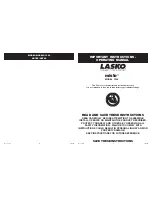
1
DB IO&M
B51131-002
®
Receiving and Inspection
Carefully inspect the fan and accessories for any dam-
age and shortage immediately upon receipt of the fan.
• Turn the wheel by hand to ensure it turns freely and does
not bind
• Check dampers (if included) for free operation of all
moving parts
• Record on the
Delivery Receipt
any visible sign of damage
Handling
Lift the fan by the base or lifting eyes.
NOTICE! Never lift by the shaft, motor or housing.
Storage
If the fan is stored for any length of time prior to installa-
tion, store it in its original shipping crate and protect it from
dust, debris and weather.
DB/DBX
DUCT BLOWER
Cabinet Fans
INSTALLATION, OPERATION AND MAINTENANCE MANUAL
Rotating Parts & Electrical Shock Hazard:
Fans should be installed and serviced by qualified person
-
nel only.
Disconnect electric power before working on unit (prior to
removal of guards or entry into access doors).
Follow proper lockout/tagout procedures to ensure the unit
cannot be energized while being installed or serviced.
A disconnect switch should be placed near the fan in order
that the power can be swiftly cut off, in case of an emer-
gency and in order that maintenance personnel are pro-
vided complete control of the power source.
Grounding is required. All field-installed wiring must be
completed by qualified personnel. All field installed wiring
must comply with National Electric Code (NFPA 70) and all
applicable local codes.
Fans and blowers create pressure at the discharge and
vacuum at the inlet. This may cause objects to get pulled
into the unit and objects to be propelled rapidly from the
discharge. The discharge should always be directed in a
safe direction and inlets should not be left unguarded. Any
object pulled into the inlet will become a projectile capable
of causing serious injury or death.
When air is allowed to move through a non-powered fan,
the impeller can rotate, which is referred to as windmill-
ing. Windmilling will cause hazardous conditions due to
unexpected rotation of components. Impellers should be
blocked in position or air passages blocked to prevent draft
when working on fans.
Friction and power loss inside rotating components will
cause them to be a potential burn hazard. All components
should be approached with caution and/or allowed to cool
before contacting them for maintenance.
Under certain lighting conditions, rotating components
may appear stationary. Components should be verified to
be stationary in a safe manner, before they come into con-
tact with personnel, tools or clothing.
Failure to follow these instructions could result in death or
serious injury.
The attachment of roof mounted fans to the roof curb as
well as the attachment of roof curbs to the building struc-
ture must exceed the structural requirements based on the
environmental loading derived from the applicable build-
ing code for the site. The local code official may require
variations from the recognized code based on local data.
The licensed engineer of record will be responsible for pre-
scribing the correct attachment based on construction ma-
terials, code requirements and environmental effects spe-
cific to the installation.
This publication contains the installation, operation and
maintenance instructions for standard units of the
DB:
Ceiling, Wall and Cabinet Fans.
• DB/TDB
• SDB/DBX
Carefully read this publication and any
supplemental documents prior to any
installation or maintenance procedure.
Loren Cook catalog,
DB
, provides additional information
describing the equipment, fan performance, available ac-
cessories and specification data.
For additional safety information, refer to AMCA Publi-
cation 410-96,
Safety Practices for Users and Installers of
Industrial and Commercial Fans
.
All of the publications listed above can be obtained from:
• lorencook.com
• 417-869-6474 ext. 166
For information and instructions on special equipment,
contact Loren Cook Company at 417-869-6474.


























